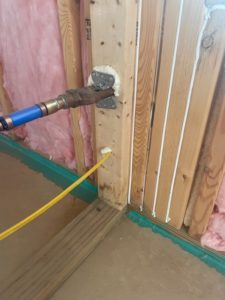Air sealing is a great way to improve your home’s value, increase energy efficiency, and create a greener living space. Properly sealing leaks in your attic, basement, and living areas will help you keep warm and cool air where you want it so your family can enjoy a comfortable, healthy home. Learn more about how air sealing works and how you can benefit from this process.
How Air Sealing Works
Air sealing is the process of eliminating gaps and cracks between the conditioned and unconditioned parts of your home. When areas aren’t properly sealed, air can move between them freely, diminishing your comfort levels and energy efficiency. Air sealing can take many forms, and a thorough job typically includes a variety of approaches. This may include caulking along gaps and cracks, adding aluminum flashing around flues or chimneys, stuffing holes, plugging open stud cavities, and covering dropped soffits.
Done correctly, air sealing will plug the holes, gaps, and cracks that allow air to pass from conditioned parts of the home to those that are unconditioned, or from the outside to the inside of your living space. This job requires great attention to detail to locate all the potential areas where air might leak through and find the most effective approach to sealing in each of these spots.

The Benefits of Air Sealing
When air moves between conditioned and unconditioned areas, it takes moisture, pollutants, and heat or cold with it. A home without proper air sealing will have free movement of air between different areas, which allows irritants and moisture into the home. This will reduce your indoor air quality and may lead to problems with allergies, asthma, mold, or mildew. The movement of hot or cold air between the outside and inside will diminish your home comfort, potentially leaving you in a home that’s hot and humid in summer and extremely cold in winter.
When you invest in air sealing for your home, you’ll enjoy a wide variety of benefits including:
- Better energy efficiency for a greener home environment
- Comfortable, consistent temperatures
- Improved indoor air quality that can help protect your health
- Lower utility costs as your home is better equipped to maintain the right temperatures
How to Know if You Need Air Sealing
We can help you identify air leaks throughout your home with a professional air leakage test. We use a blower door test to identify air leaks. To do this, we close all the doors and windows and place a large fan in the main entryway. This pulls air out of the house and creates suction that will draw outside air in through any cracks or openings around the home. Our technicians will carefully observe the home and use a variety of tools such as thermal imaging cameras or heatless smoke to identify potential problem areas.
You can also identify air leaks yourself by looking for:
- Damaged weather stripping around doors and windows
- Cracks or gaps along the walls, particularly where they meet the floor or ceiling
- Dirty spots on the walls or flooring that can indicate air leakage
- Dirty insulation that’s the result of air moving in and out
- An insecure flue damper in the fireplace
In addition to these visible indicators that you need to seal your home, you may also notice some of the symptoms of a poorly sealed space. These include:
- Hot and cold spots around the home
- An inability to maintain comfortable temperatures in your living space
- Asthma and allergy symptoms that are worse when you’re in the house
- Difficulty with mold, mildew, or rusting fixtures in the home
- An unexplained increase in your utility bills over time
Key Places to Air Seal
Air sealing is especially important in the attic. This part of the home is impacted by the “stack effect” which causes air to move in and out of the attic as temperatures change due to the difference in density between indoor and outdoor air. In the warm-weather months, the stack effect causes cool air to drop to the basement while hot air is pulled into the attic space from outside. In winter, the stack effect pulls cold air from outside into the basement and pushes your heated air up into the attic. In both instances, you’re losing air that you’d like to keep in your living space to other parts of the home.
You can minimize the stack effect with proper sealing in your attic. This will help you maintain consistent, comfortable temperatures throughout your home. It’s best to work with an experienced contractor for this project, especially if your attic is small, suffers from moisture problems, has little to no ventilation, or has vents from the kitchen, clothes dryer, or bathroom that send air into this space. You should plan to seal your attic before insulating it to get the best results from both projects.
If you have a basement, this is the second area that you should target for air sealing. This will help target the stack effect on the other end of the house. Other places that you may want to air seal include:
- Any exterior parts of the home where the siding meets the foundation or roof
- The area where your siding or roof meets the chimney
- Around windows and doors
- Spots where plumbing, cables, wires, or vents extend through the exterior walls
- Behind light switches, electrical outlets, and other receptacles
To learn more about how Energy Diagnostics team of air sealing professionals help builders achieve tighter more energy efficient homes, contact us today.
